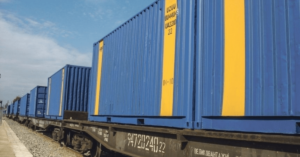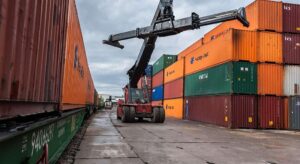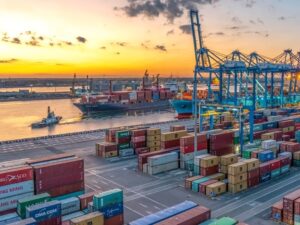
In 2024, Ukrzaliznytsia JSC (UZ) increased the volume of cargo transportation in containers by rail by 28% compared to the previous year – up to 258185 twenty-foot equivalent units (TEUs), said Valery Tkachev, Deputy Director of the Commercial Department.
According to him, 162,725 TEUs (63%) were transported on export routes, imports amounted to 55,689 TEUs (21.3%), domestic transportation – 38,681 TEUs (15%), and transit – 1,190 TEUs (0.5%).
The leader among cargoes in terms of containerized transportation was grain cargo, which accounted for 46% of the total volume of transportation, ferrous metals – 20%, oil cake – 9%, oil – 8%, sugar – 4%, synthetic resins – 3.7% and starch and molasses products – 3.6%.
Tkachev noted that one of the main trends in intermodal transportation through Ukraine in 2024 was the absence of a seasonal/peak increase in cargo transportation in November-December, although this period is usually characterized by a seasonal increase in transportation.
According to the UZ representative, the possible reasons for this phenomenon were the low cost of using grain cars – UAH 200-300 per day, which prompted farmers to return to using this type of cargo transportation. Also, due to the reopening of seaports, grain exports have been reoriented – 86-92% of grain is exported through seaports, and grain is transported to ports in grain wagons.
The reduction in the cost of using grain wagons also led to a decrease in the volume of grain cargo transportation in containers in the second half of 2024.
Tkachev also added that the share of rolling stock used by Liski, in particular, fitting platforms, decreased by 24%.

Ukraine has resumed container transportation through the Black Sea: a ship with containers entered one of the ports of Greater Odesa, Chornomorsk, on April 3, the Odesa-based Dumskaya newspaper reported.
According to the report, the pioneering vessel was the T Mare, which flies the Panamanian flag. It is not classified as a container ship, but a vessel for the transportation of general cargo.
The publication noted that this is not yet a full-fledged specialized vessel, but a so-called feeder, which will be loaded with containers and then sent to a foreign hub for further transshipment to ocean container ships of global container lines.
According to MarineTraffic, a provider of ship tracking and maritime analytics, the vessel left Chornomorsk for the Romanian port of Constanta.
The T MARE is a containerized cargo vessel flying the Panamanian flag. Its total length (LOA) is 105 meters and width is 17 meters.
As reported, in March, the Ministry of Community Development, Territories and Infrastructure announced that in early April, Odesa ports would receive the first container ship since the beginning of the war.

The first container transportation through the Ukrainian Sea Corridor may be carried out within two to three weeks, said Yuriy Vaskov, Deputy Minister of Community, Territorial and Infrastructure Development.
“All five container terminals are ready to handle (containers – IF-U). Almost all of them are involved in transshipment of agricultural and other products. But containers are a priority, and they are negotiating. I hope that in two or three weeks we will get the first measures,” he said at a roundtable discussion on the challenges facing Ukrainian foreign trade organized by the Center for Economic Strategy on Thursday.
According to his forecast, terminals and container lines will resume work in stages: “first the first line, then the second, and then the third.”
Moreover, Vaskov noted that feeder ships will start moving, and container lines will follow them if there are no incidents.
Vaskov added that the Ministry of Reconstruction also hopes to resume road ferry service within two weeks, and rail ferry service in two months.
According to him, rail ferry transportation covers all types of cargo, except for dangerous goods.
The deputy minister noted that container services between Ukraine and Romania from the port of Reni and between Romania and Turkey from the port of Izmail are already operating in the Danube ports.
Vaskov added that the Ukrainian Danube Shipping Company is also ready to transport containers up the Danube, but so far there have been no such shipments.
In total, he said, 1.8 million tons of cargo passed through the Danube in February, about 50% of the maximum reached in 2023, and together with the Ukrainian Sea Corridor, transportation in February reached almost 10 million tons, or 75% of the pre-war volume.